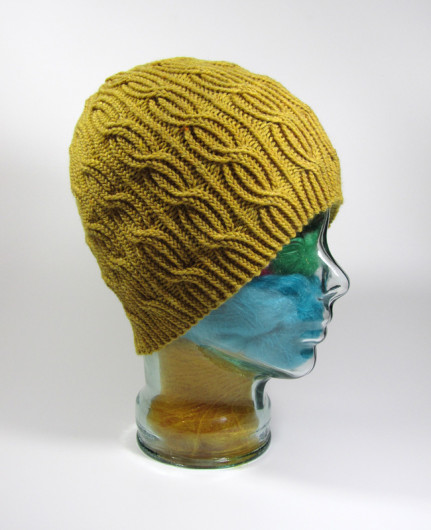 This is is Lina, designed by Johanna of Joko Knits. Lina is a free pattern available on Ravelry, with instructions in Finnish and English. Being the mono-lingual me, I used the English version. It is a great little hat, knitted here in Stonehedge Fiber’s Shepherd’s Wool DK. The yarn’s been discontinued, apparently. If you can find a supply, I give it a very positive recommendation.
This is is Lina, designed by Johanna of Joko Knits. Lina is a free pattern available on Ravelry, with instructions in Finnish and English. Being the mono-lingual me, I used the English version. It is a great little hat, knitted here in Stonehedge Fiber’s Shepherd’s Wool DK. The yarn’s been discontinued, apparently. If you can find a supply, I give it a very positive recommendation.
Here’s Lina again, knit in Wollmeise Merino DK left over from Isaac’s Sirdar Cabled Cardigan. I finished one Lina and immediately decided to knit another.
This is not brioche, by the way. Fifty-six years knitting and I’ve still not learned to knit true brioche. But it’s definitely on my “to do” list. These are twisted stitch cables.
Now that I’ve enticed you in with how cool this hat turns out, the pattern has its challenges for those (like me) not well-versed in the streamlined European way of writing patterns. Actually, there’s only one complication. Even with photos showing how to do the cabling, I just couldn’t get the hang of this cable move:
“Cable: Slip seven stitches purl wise into right needle. Pick up the three first slipped stitches back to left needle (see picture) and remove all seven stitches from the right needle. Pick up the four loose stitches to right needle behind the left needle and move them back to the left needle. Knit (k1tbl, p1) three times, k1tbl.”
If that makes every bit of sense to you, the rest of the pattern is a snap. Go for it!
Here’s another photo to encourage you to persevere if your knitting head did what my knitting head did upon reading that cable direction.
Some people, especially those (like me) who need to use a cable needle to work a maneuver like that need a bit more translation. After poking around on Raverly projects, here’s what I learned works:
k 1tbl, p1, cable over the next 7 stitches, p1. Those 10 stitches are repeated across the round. And this how the 7-stitch cable is worked: hold 3 stitches in front, on the next 4 stitches, k1tbl, p1 k1tbl, p1. Then, work the 3 stitches held on the cable as k1tbl, p1, k1tbl.
I know. You’ll think that’s wrong. Because the 4 stitches worked as the first part of the cable are reversed in terms of how they appear on the needle. It will look wrong, but it will work wonderfully well. The reversal can’t be seen because the change is tucked into the twist.
It is such a blast to see what seems to be so wrong turn out to be so right.
My gold Lina is larger sized. The brown one is 120 stitches cast on and the gold is 140.
Some folks don’t care for the way the pattern has you work the crown decrease. Done as Johanna designed it, the crown decreases look like this:
I have no problem with the way that looks. And if I’d been a bit less tentative I bet it would have looked better. Besides, the top of your head is probably only visible to the tall and they oughtn’t to be looking down on your head anyway.
Some Ravelers follow the crown decreases posted by functionalknits on Ravelry on her “Cashmere Lina for Nat” project post. Nat was awfully lucky to get that cashmere hat, by the way. And the decreases look quite nice. I tried her Nat hat way on this Lina:
It’s a tad more organized looking, but there’s something a little funky going on at the top of the cables. I’m well-satisfied with the original. The pattern works with increases (or decreases) of 20 on the cast-on if you work the original crown decreases. But (from what I’ve read) 10-stitch incremental changes work if you use functionalknits’ crown decrease modification.
Lina totally passed under my radar for many years. At the moment there are 1753 Lina projects posted on Rav. Our knitting universe has so many generous designers offering these fine, free patterns. Lina is definitely a keeper.




